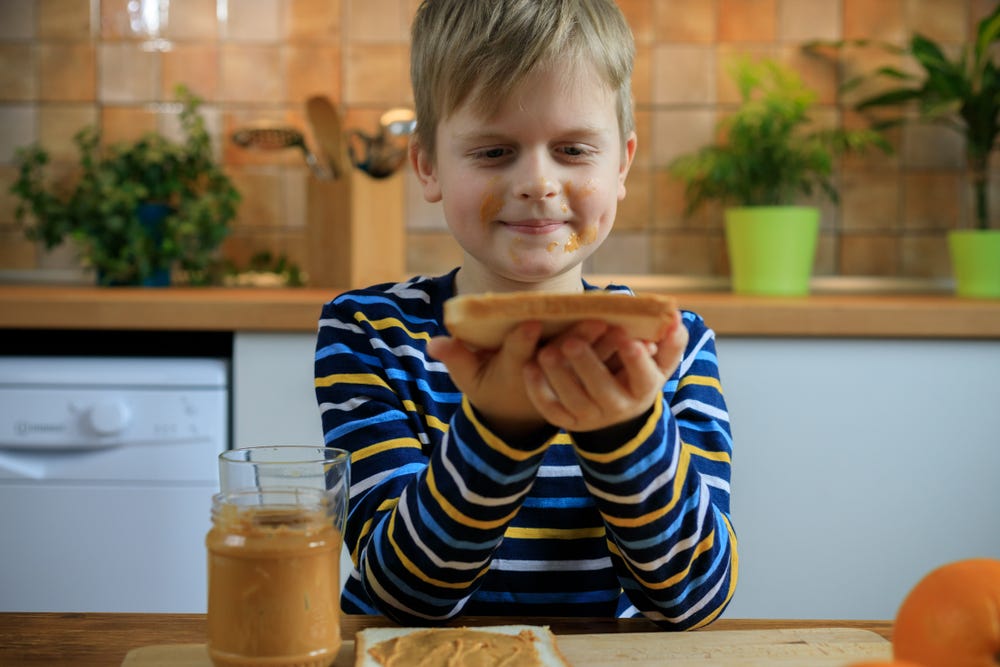New therapy helps peanut-allergic kids safely consume peanut butter
A new study shows that gradually increasing peanut butter intake can help children with peanut allergies build long-term tolerance.

A recent study suggests that children with peanut allergies can build tolerance by gradually increasing their daily peanut butter intake over 18 months. (CREDIT: CC BY-SA 4.0)
Children with high-threshold peanut allergies may have a new path toward desensitization through a simple and inexpensive method.
A recent study suggests that gradually increasing daily doses of store-bought peanut butter over 18 months significantly improves tolerance to peanuts. Conducted by researchers at the Icahn School of Medicine at Mount Sinai and funded by the National Institutes of Health, the study offers promising results for children who can initially tolerate at least half a peanut.
Unlike existing treatments that focus on children highly sensitive to even trace amounts of peanuts, this approach targets those who can already handle small amounts but still experience allergic reactions.
A New Approach to Peanut Allergy Treatment
Traditional management of peanut allergies involves strict avoidance, but oral immunotherapy—gradual exposure to increasing amounts of peanut protein under medical supervision—has emerged as an alternative.
However, past clinical trials focused on children with low-threshold peanut allergies, who react to even minimal peanut exposure. These treatments, including FDA-approved options, help reduce the severity of accidental reactions but do not allow patients to consume normal amounts of peanuts safely.
In contrast, this new study targets children with high-threshold peanut allergies—those who can tolerate at least half a peanut without an immediate severe reaction. With an estimated 800,000 children in the United States falling into this category, researchers sought to determine whether controlled peanut exposure could help them tolerate greater amounts without allergic responses.
Dr. Scott Sicherer, lead researcher and Director of the Elliot and Roslyn Jaffe Food Allergy Institute, explains the significance of the study: “Our findings open the gateway to personalized threshold-based treatments of food allergy and will encourage additional studies that delve deeper into peanut and other foods for this approach that might be a game-changer for the majority of people with food allergies.”
How the Study Was Conducted
Researchers recruited 73 children, ages 4 to 14, and randomly assigned them to two groups: one that continued avoiding peanuts and another that followed a controlled peanut ingestion protocol.
Related Stories
The children in the peanut-ingestion group started with 1/8 teaspoon of peanut butter daily, increasing their intake every eight weeks under medical supervision. By the end of the 18-month period, they were consuming up to one tablespoon of peanut butter daily.
During the study, no participants in the peanut-ingestion group required epinephrine during home dosing, and only one child needed it during a supervised dose escalation visit. This suggests that the gradual exposure method carries a low risk of severe allergic reactions when conducted under medical guidance.
At the conclusion of the treatment period, children in both groups underwent a carefully monitored oral food challenge to assess their peanut tolerance. All 32 children in the peanut-ingestion group who participated in the test were able to tolerate nine grams of peanut protein—the equivalent of three tablespoons of peanut butter. In contrast, only three of the 30 children from the avoidance group could consume the same amount without an allergic reaction.
Dr. Julie Wang, co-senior author of the study, highlights the implications of these findings: “More than half of people with peanut allergy can tolerate half a peanut or more. We thought that this group of people might be treatable if we took a different approach to peanut oral immunotherapy. We were thrilled to find that this treatment strategy was even more successful than we had anticipated.”
Long-Term Benefits and Sustainability
To determine whether the benefits of peanut exposure persisted over time, researchers conducted a follow-up phase. Children who successfully tolerated nine grams of peanut protein were instructed to consume at least two tablespoons of peanut butter weekly for 16 weeks. Afterward, they avoided peanuts entirely for eight weeks before undergoing another oral food challenge.
Among the 30 children who completed the final challenge, 26 (86.7%) continued to tolerate nine grams of peanut protein, demonstrating sustained unresponsiveness. In comparison, only three children in the avoidance group naturally developed tolerance to peanuts.
When accounting for all study participants, 68.4% of those in the peanut-ingestion group achieved sustained unresponsiveness, compared to just 8.6% in the avoidance group.
Dr. Sicherer emphasizes the significance of these results: “These study results are very exciting and a huge step forward in personalizing food allergy treatment. My hope is that this study will eventually change practice to help these children and encourage additional research that includes this approach for more foods.”
Expanding Research and Future Applications
The success of this study raises questions about whether similar strategies could work for other food allergens. Previous research has shown that many children with milk and egg allergies can safely consume these foods when baked, altering treatment approaches worldwide.
Dr. Wang notes that the next step is to refine methods for identifying children who would benefit most from this therapy. Currently, the best way to assess peanut tolerance requires an oral food challenge, which involves controlled exposure to an allergen with a risk of triggering a reaction. Finding non-invasive markers for determining tolerance levels could improve the accessibility of this treatment approach.
Additionally, researchers hope to explore whether variations of this peanut exposure method could help children develop lifelong immunity rather than temporary desensitization. Long-term follow-up studies will be essential in determining the lasting effects of this treatment.
Dr. Jeanne Marrazzo, Director of the National Institute of Allergy and Infectious Diseases, highlights the broader implications of the study: “Children with high-threshold peanut allergy couldn’t participate in previous food allergy treatment trials, leaving them without opportunities to explore treatment options. Today’s report focuses on this population and shows that a very safe and accessible form of therapy could be liberating for many of these children and their families.”
As research continues, this simple and cost-effective approach to treating peanut allergies may offer a practical solution for thousands of families.
The findings suggest that many children with peanut allergies could safely expand their diets and reduce their risk of severe reactions, improving their overall quality of life.
Note: Materials provided above by The Brighter Side of News. Content may be edited for style and length.
Like these kind of feel good stories? Get The Brighter Side of News' newsletter.
Rebecca Shavit
Science & Technology Journalist | Innovation Storyteller
Based in Los Angeles, Rebecca Shavit is a dedicated science and technology journalist who writes for The Brighter Side of News, an online publication committed to highlighting positive and transformative stories from around the world. With a passion for uncovering groundbreaking discoveries and innovations, she brings to light the scientific advancements shaping a better future. Her reporting spans a wide range of topics, from cutting-edge medical breakthroughs and artificial intelligence to green technology and space exploration. With a keen ability to translate complex concepts into engaging and accessible stories, she makes science and innovation relatable to a broad audience.



